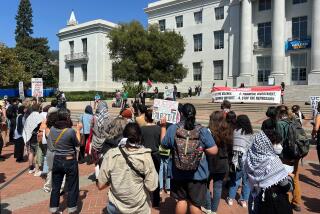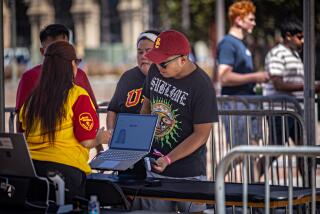CSUN’s Recovery Enters 2nd Semester : Education: Less chaotic term is expected for students. Many trailers will still be used, but most classes forced off campus by quake damage will return.
NORTHRIDGE — Thanks to construction crews who worked round the clock during the summer, Cal State Northridge students will return Monday to a campus that is a little closer to resembling its pre-earthquake state.
Most of the classes still will be held in trailers, professors still will compete with noisy construction crews for students’ attention and the collapsed multilevel parking structure C--one of the most horrific images from the devastating Jan. 17 temblor--still will sit crumpled behind a chain-link fence.
But nearly all the classes that were forced to relocate to off-campus sites during the spring semester will be held on campus this fall, three new buildings under construction at the time of the quake will open and the core of the Delmar T. Oviatt Library--considered the heart and soul of the campus--will reopen for research and study.
“We are ready for a full program in the fall,” CSUN President Blenda J. Wilson said.
CSUN officials predict less chaos Monday than on Feb. 14, opening day of the spring semester, which was plagued by unusable temporary classrooms and confusion over how to get around the 353-acre campus that suffered nearly $350 million in quake damage.
For one thing, the campus layout remains virtually the same as it was in the spring, with its “recovery villages” of portable trailers for classrooms and offices scattered around the campus. Repairs will continue through the semester and officials are optimistic that they can remove as much as 25% of the trailers by the end of the year.
Yellow safety signs depicting a hard hat with a mortarboard will warn students that they are at a site where “academic and construction people meet.” Chain-link fences that had surrounded construction sites have been replaced with plywood fences that are safer and more appealing. Students will be allowed to use the fences as canvases to “communicate.”
Maneuvering around campus could also be easier because there may be fewer students to bump into.
Enrollment for the spring semester, which started a month after the quake and only two weeks late, was 24,813, only about 450 less than had been expected, according to Lorraine Newlon, director of admissions and records.
As of last week, just over 23,000 students had registered for fall, and Newlon said she expects a final count of between 24,000 and 25,000. If those numbers hold up, that still would be about 10% less than enrollment last fall, when 27,282 students registered.
Newlon attributed the drop to a general decline in enrollment at CSU campuses statewide and a 10% increase in fees rather than to any concerns about earthquake-damaged buildings.
“We have not had too many people explicitly say, ‘I’m not coming because of the earthquake,’ ” Newlon said.
“Most of our students come from the surrounding area and our students are not going to give up on Northridge so easily.”
Students should also have an easier time getting to their labs this fall because the opening of three new buildings and the reopening of at least parts of all four science buildings will mean fewer classes off campus.
The new buildings are business administration and economics, education and a new engineering wing.
“We are making dramatic steps forward toward resuming use of regular classrooms and labs,” said CSUN spokesman Bruce Erickson.
Because so many buildings were damaged, CSUN officials conducted seismic reviews of every building on campus, in many cases breaking away concrete to inspect steel connections for cracks. The quake also shook loose asbestos in many buildings, and it had to be removed.
Other buildings that will be at least partially opened this fall include the first floor of Sierra South, the Magaram Center, the Art & Design Center, Chisholm Hall, and the music, physical education and speech and drama facilities.
“There is a lot of anxiety about building safety, but we can assure everyone that any building we open is safe,” Erickson said.
Among those closed indefinitely are Sierra North and Tower, the Computer Center, fine arts building, Monterey Hall and wings in the engineering and speech and drama buildings.
The administration building is also closed indefinitely, and is at the bottom of the priority list for repairs, along with parking structure C, Erickson said.
Dorms for 3,000 students have been refurbished with new carpets and furniture, and newly wired for cable television and computers. The Student Union, bookstore and most of the eating areas are also open.
Opening classrooms for labs and the main portion of Oviatt Library were made a priority after a survey of students and faculty members indicated they were the most important. Prior to the survey, officials had decided to build a warehouse-type structure as a temporary library.
“Students and faculty really missed the library,” Erickson said. “We found out it was the center of campus life. It was an oasis for people.”
Faculty President Nancy Owens, a professor of family environmental sciences, said the faculty had been excluded from early decisions about earthquake repairs, a situation that created tension between professors and administrators. The creation of faculty-represented committees to oversee major repair alleviated the friction.
“If it had not been for the faculty, Oviatt would not be opened,” said Owens, who has taught at CSUN for 25 years. “We think that without a library, you are not a university. The library is the nerve center of the campus.”
During the spring semester, students had to take an hourlong shuttle ride to use the UCLA library or use two makeshift library facilities on the CSUN campus, a 15,000-square-foot hall known as the North Annex and a 13,000-square-foot Lindley Dome. Both temporary library annexes will remain open until the Oviatt is completely repaired.
Most of the damage to the 220,000-square-foot Oviatt was to its two wings. The wings will remain closed as repairs continue, but the building’s 130,000-square-foot center will reopen.
More than 600,000 of the library’s 1.1 million volumes ended up on the floor after the quake. Thomas Enterprises, the company that helped restore the collection at the Downtown Public Library after the devastating fire there, was hired to reshelve the books.
“Every book was individually dusted,” Erickson said.
There should be plenty of parking spaces on campus, although they may not be convenient. There will be 6,500 spaces available for student parking, but about half of them are in north campus lots. Free shuttle buses will circle the campus every eight minutes.
Campus officials said that during the spring semester, the lots never filled to capacity. However, the lots did not open until after the semester began and regulations concerning street parking around the campus had been suspended for most of the semester.
All street parking regulations will be enforced this fall.
Due to funding uncertainties, it is unclear when the campus will be totally repaired.
“We’re not all the way back, but we’re getting there,” Owens said.
* VALLEY BRIEFING: A guide to getting around the CSUN campus. B2
More to Read
Sign up for Essential California
The most important California stories and recommendations in your inbox every morning.
You may occasionally receive promotional content from the Los Angeles Times.










